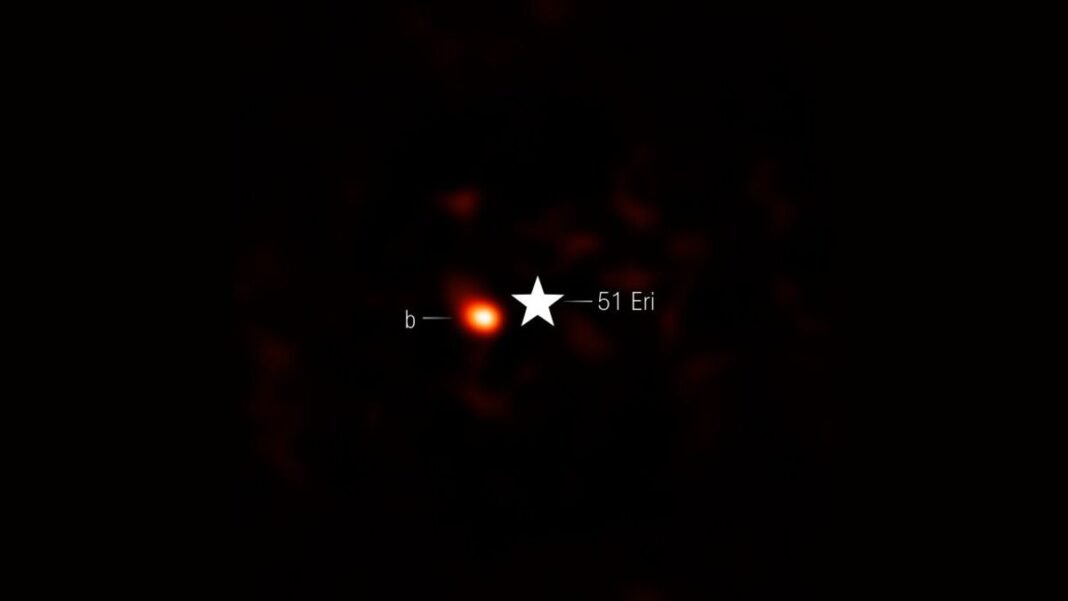Astronomers Unveil Revolutionary Images of Exoplanets Using James Webb Space Telescope
Exciting new images of exoplanets in the HR 8799 and 51 Eridani star systems have been unveiled by astronomers, showcasing the groundbreaking capabilities of the James Webb Space Telescope (JWST). This advancement not only enhances our understanding of these distant worlds but also opens new avenues for exploring the possibility of extraterrestrial life.
Lead: Last week, astronomers made headlines as they unveiled astonishing new images of planets in the HR 8799 and 51 Eridani star systems, thanks to the innovative use of the James Webb Space Telescope (JWST). Led by Ph.D. candidate William Balmer from Johns Hopkins University, this study marks a significant leap in our understanding of exoplanets, how they form, and the exploration for extraterrestrial life. The findings were shared in a detailed interview with Space.com, highlighting the revolutionary potential of direct imaging in the field of astronomy.
Challenges of Direct Imaging of Exoplanets
Astronomers have faced significant difficulties in capturing images of distant planets. Some of the main challenges include:
– **Light Interference**: The bright glare of a star can dilute the faint light from a planet, making it difficult to study the planet’s atmosphere.
– **Distance**: Most exoplanets are located incredibly far from Earth, which limits the ability to obtain clear images.
William Balmer elaborated on these challenges, noting, “Direct imaging is critical for studying distant planets because it tells us the most information about the structure and composition of their atmospheres, independent of the light from the host star.”
Revolutionary Technology of the JWST
The JWST is equipped with cutting-edge technology that enhances its capability to study exoplanets, including:
– **Large Mirror**: A generous mirror size that allows for the capturing of very faint emissions.
– **Specialized Instruments**: Tools designed to detect emissions in the mid-infrared range of the electromagnetic spectrum.
Balmer noted, “Different gases at various pressures and temperatures in the planet’s atmosphere will absorb or emit light of specific wavelengths, and we can use these chemical imprints on the light to model with increasing clarity not only what planets are made out of, but how they might have formed.”
Innovative Techniques for Capturing Images
In this groundbreaking study, Balmer and his team adopted unique techniques to capture images of the exoplanets in HR 8799 and 51 Eridani. One of their key strategies involved the following:
– **Use of Coronagraphs**: Originally designed to block starlight, the team modified the JWST’s coronagraph masks to allow more light around the edges, maximizing planetary visibility. Balmer humorously stated, “I like to joke that for this paper we ‘used the coronagraphs wrong,’ but what we really did was use a very thin part of the coronagraph mask.”
The team achieved a remarkable feat by capturing coronagraphic images that offer clearer insights into planetary atmospheres than ever before.
First-Ever Images at Significant Wavelengths
The study’s results are historic for several reasons:
– **First Image at 4.6 Microns**: This new data on HR 8799 is crucial since Earth’s atmosphere absorbs much of the light at this wavelength, rendering ground-based observations nearly impossible. Balmer added, “Earth’s atmosphere has only a brief window of transparency at 4.6 microns.”
– **Observations at 4.3 Microns**: These wavelengths are completely blocked by Earth’s atmosphere, making the JWST’s observations particularly significant. “The most exciting wavelength we had access to with the JWST is at 4.3 microns, where none of these planets had been observed before,” he explained.
The JWST’s positioning in space enables it to bypass these atmospheric limitations, facilitating groundbreaking discoveries.
Insights into Planetary Atmospheres
The images revealed by the JWST allowed scientists to obtain valuable information about the exoplanets’ atmospheric compositions:
– **Carbon Dioxide Levels**: Analyzing carbon gas levels helps determine the past formation processes of planets. Balmer elaborated, “Since the strength of the carbon dioxide feature in the HR 8799 planets’ atmospheres is so strong, we are fairly confident that they have a larger fraction of heavy elements compared to their host star.”
This knowledge gives insight into the materials from which these planets formed.
Unexpected Atmospheric Diversity
The study also uncovered intriguing variations among the colors of the planets in the HR 8799 system, which signifies differing atmospheric compositions and structures. Balmer commented, “The differences between the HR 8799 planets are quite interesting because previously these planets have looked relatively similar in the near-infrared.”
The colors may indicate:
– **Vertical Mixing**: This process can influence where atmospheric gases are located, affecting the molecules scientists detect.
– **Unexpected Composition**: For instance, Balmer noted that they observed little methane and more carbon monoxide than anticipated, suggesting dynamics within the planet’s atmosphere are more complex than previously thought.
Future of Exoplanet Research
The findings from this research open many possibilities for examining additional systems and deepening our understanding of gas giants. Balmer expressed optimism, stating, “Our team has been awarded 23 more hours of JWST time to study four additional planetary systems.”
The aim is to further understand whether these gas giants formed through core accretion, a process critical for grasping how they might stabilize or influence smaller, rocky planets.
Conclusion: The groundbreaking images and data captured by the James Webb Space Telescope signal a new era in exoplanet research. As astronomers continue to explore the nuances of distant worlds, the potential for discovering extraterrestrial life and understanding planetary formation processes becomes increasingly attainable.
Keywords: James Webb Space Telescope, exoplanets, HR 8799, 51 Eridani, coronagraphs, atmospheric composition, carbon dioxide, space research.
Hashtags: #Exoplanets #HR8799 #51Eridani #JWST #Astrophysics #SpaceResearch #Astronomy #ExtraterrestrialLife
This structured article provides a compelling narrative, accompanied by key information, quotes from experts, and engaging subheadings, making it accessible and optimized for search engines.



